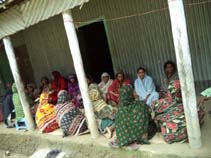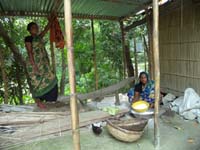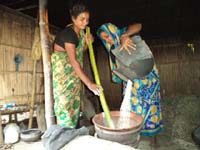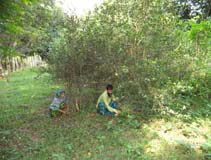CREED started its Micro Credit Program in 1994. Organizing basic literacy courses and awareness programs, CREED discovered that the economical situation of the poor could not be improved without cash money. This is the reason why they started their loan program. The program is also meant to create the future financial sustainability of CREED.
The objectives of the Micro Credit Program are to:

- Alleviate rural poverty by providing loan for income generating activities
- Raise the socio-economic status of rural ultra poor women
- Raise the awareness of the community people about their legal and social rights
- Teach basic skills for undertaking income generating activities.

The program started in Gazipur in 1994 with 17 savings groups.
Now CREED has 165 savings groups in 4 branches with a total of 4035 members (report up to June, 2013).
CREED is running the credit program out of two different sources:
CREED General Fund , started in 1994
Palli Karma-Shahayak Foundation (PKSF ) , started in 1998
IMPLEMENTATION
The area chosen by CREED to implement the Micro-Credit Programme would have good infrastructure conditions. Furthermore there should be sufficient market opportunities in the area for beneficiaries to sell their products. The criteria for prospective members to be admitted to a savings group are as follows:

- Their economical status should be that of a marginal farmer or day laborer;
- They should be a permanent resident of the area;
- They should be excluded from commercial loans;
- Women should be ultra poor;
- The minimum age is eighteen years.
After selecting a suitable area, CREED organises an initial meeting and provides information on the micro credit program. When enough people show interest, a group of minimal fifteen and maximum thirty members is formed. CREED’s supervisor guides and observes the savings group for thirteen weeks and considers the members’ honesty, sincerity and solidity of family relationships.
The group chooses their own president, secretary and cashier. They receive a five-day training on leadership, group management committee, maintaining accounts, local resources, income generating activity identification etc.

Three other group members receive training on human resource development. This training also takes five days and covers subjects such as: rural poverty, causes of poverty, relationship between power and poverty, the position of women in Bangladeshi society. The three trainees are supposed to pass on their knowledge to the other group members during weekly meetings.
After thirteen weeks, group members are invited to present a loan application. Together with the supervisor, members select an area of activity. The supervisor advises them on the feasibility of their choice in terms of cost and profit and market opportunities. Once their choice is made, they receive a seven-day skills development training. Topics are mostly: poultry raising and rearing, kitchen gardening, plant/seed nursery, fishery, mat making, chalk making and small trades.

The members, assisted by the supervisor, have to fill out a loan application form. The area manager then visits the group and writes a report on the members’ loan application. The project manager checks this report and sends it for final approval to the head office in Dhaka.
The members have to save a weekly amount of at least 20/= taka. They pay weekly installments on their loans. The interest rate is 25% as on declining method. The grace period is two weeks. he savings group meetings are conducted by a supervisor and held once a week.
The meetings include an awareness program. The supervisor gives information and presides over discussions on various subjects like health, education, arsenic, development awareness, sanitation, childcare, divorce etc. After that the supervisor collects the savings money and the installments.
All members of a savings group have to fill out an admission form, a basic information form, a loan application form and a loan agreement form (the latter two only when they take a loan).
The basic information form contains information on the initial economic status of the beneficiary and her or his family. The form is developed by PKSF and is used by CREED in their PKSF as well as in their CREED General Fund savings groups.

Results
At present , the total of beneficiaries are 4035, of which 90% are women.
Only 25% of the women use the loan by themselves. In all the other cases the husband or father in law or another male relative use the loan.
The percentage of loan defaulters is only 2%. This means that 98 % of the beneficiaries are able to make a profit and can pay their installments.
Since 1994, 5916 members left the savings groups for a variety of reasons. It may be they became solvent and don’t need a loan from CREED. It may be they migrated to another area or had financial problems.
As per field report of June, 2013 the Micro credit position of CREED is given in the Following table:
| Branch | Working Area | Total Group | Total Member | Total Loaner | Savings outstanding | Loan outstanding | % of Realization | |
| District | Upazila | |||||||
| Fuldi | Gazipur | Kaligonj | 71 | 2004 | 1385 | 17490990 | 37255247 | 99.43% |
| Kaligonj | -do- | -do- | 21 | 446 | 335 | 3577078 | 8219403 | 98.37% |
| Pubail | -do- | Sadre | 43 | 919 | 779 | 4716819 | 16736789 | 96.41% |
| NotanKahela | Tangail | Mijapur | 30 | 666 | 446 | 6914663 | 7687884 | 99.21% |
|
Total |
165 | 4035 | 2,945 | 32699550 | 69899323 | 98.71% | ||
Cumulative Disbursement Figure (from November,1994 to June, 2013) :
| Working Area/Branch | Cumulative Number of Loan Disbursement | Cumulative Amount of Disbursement (Taka) | |
| Male | Female | ||
| 1. Fuldi Area | 2517 | 17056 | 346327000 |
| 2. KaliganjMainCity Area | 349 | 4815 | 82267000 |
| 3. Pubail Area | 455 | 5329 | 118245000 |
| 4. Kahela Area | 190 | 5039 | 82085000 |
|
Total |
3511 | 32239 | 628924000 |
|
Total figure in US $ |
7961063.29 | ||
